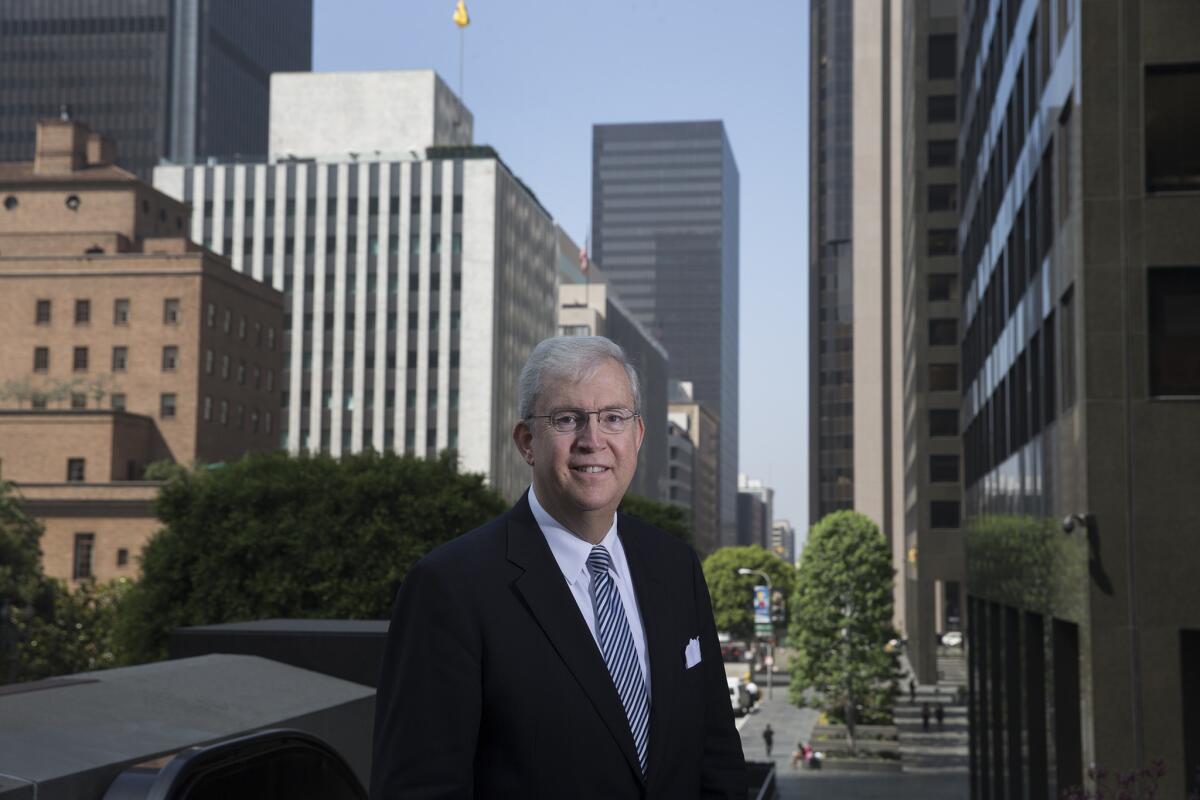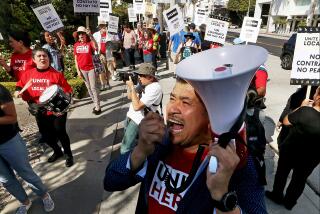High costs for L.A. County businesses bring top value, exec says

Bill Allen is president of the nonprofit Los Angeles County Economic Development Corp.
It’s Bill Allen’s job to persuade you to set up business in Los Angeles County — or to stay put if you’re already here.
Allen is president of the Los Angeles County Economic Development Corp., a nonprofit supported by private and county funds that provides consulting, research and other services to promote business in the region.
The county has a $640-billion economy, larger than many nations’. But it was hard hit by the Great Recession, and the county only now is finishing replacing the roughly 300,000 jobs that were lost in the downturn.
The county’s jobless rate, at 7.6% in April, remained well above the national jobless rate of 5.4%. Manufacturing jobs in the county have dropped from 450,000 in 2007 to 350,000 today.
Allen, 57, came from one of the county’s top industries: entertainment. Son of the late comedian Steve Allen, Bill Allen formerly ran MTM Television and was a CBS executive.
We asked Allen about the L.A. County economy’s outlook. A move by the city of Los Angeles to lift the minimum wage to $15 an hour by 2020 is a key element in that outlook. But the county has asked the economic development group to study the issue, so Allen said he had to limit his comments. Here is an edited excerpt:
How valid is the oft-heard complaint that L.A. County and California aren’t business-friendly enough, starting with taxes?
It’s fair to say that neither California nor the Los Angeles area are the lowest-cost places in this country in which to do business. But we believe they are some of the highest-value places.
Highest-value?
No other region in the U.S. possesses the size, scale and diversity of our collective intellectual and physical assets. This is the best region in the country to research, design, create, produce and export both products and services. We have an enormous labor force here, world-class research institutions and a world-class connected infrastructure to the global economy.
Meaning?
The Port of L.A. and the Port of Long Beach are the two largest seaports in the Western Hemisphere. More than 40% of all the water-borne cargo entering the U.S. comes in through these ports. L.A. International Airport is the largest origin-and-destination airport in the world. The fastest-growing markets are along the Pacific Rim, and we have the cultural connections to every country along the Pacific Rim.
A number of big companies have moved their headquarters out of Los Angeles in the last 20 years. Does it matter?
It is important for us to do everything in our power to prevent those sorts of moves. Large employers, particularly headquarters companies, are very valuable to a regional economy and its society beyond the economic benefits they provide.
They attract suppliers and vendors but also they tend to be good civic stewards. Headquarters companies tend to invest in the cultural and human-need service organizations in the region. There was a lot of publicity about the loss of Arco’s very generous charitable contributions to the region when Arco was acquired by British Petroleum in 2000. And that was quite real.
Other than mergers, why do companies leave?
Some of the highest-profile companies that relocated their headquarters didn’t do it for a cost reason. For instance, Northrop Grumman did not relocate its headquarters from Los Angeles to Virginia in 2011 for cost reasons. It did so to be closer to its prime buyer: the United States government. We still have more than 20,000 people working at Northrop Grumman facilities in L.A. County.
What other obstacles do you face in recruiting or keeping companies in the county?
Billion-dollar incentives are offered by other states to large companies to relocate, particularly to southeastern U.S. states. Those states find California to be the most attractive fishing pond.
What’s one of your recent success stories?
A Chinese manufacturer called BYD, which makes cars, buses, solar systems. We were successful in attracting its North American headquarters to Los Angeles and its North American manufacturing facility for its electric transit buses to Lancaster. BYD employs about 60 or 80 there now to produce its initial bus orders.
What’s the impact of the higher minimum wage in Los Angeles?
There will be a benefit to many people who have been low-wage earners. But there also are potential negative impacts to some of those individuals and to some of the companies that employ them.
Because business’ labor costs will climb, and that could lead to less hiring or layoffs?
The city of L.A. has to be very careful because over the last 35 years it has underperformed the rest of the county in job creation. Thirty-five years ago the county had a 7.5-million population. Today it has 10 million. But with that extra 2.5 million people we’ve only created a few hundred thousand jobs countywide. The city of L.A. alone has added 1 million people to its population but actually lost jobs in that period, so the city has to be very careful as they enact these policies.
What’s the “Strategic Plan” you started a few years ago to improve matters?
It’s a plan in which we’ve built some of the strongest consensus I’ve seen between business, labor, government, education and the environmental community about a path forward for the economy. Now we’re going to be talking even more about investing in human capital, starting with early childhood education. The greatest predictor of one’s earnings ability is one’s education.
And now you want the public’s input?
There will be a series of public meetings. We also want people to communicate with us through social media with their ideas on how we grow this economy.
More to Read
Inside the business of entertainment
The Wide Shot brings you news, analysis and insights on everything from streaming wars to production — and what it all means for the future.
You may occasionally receive promotional content from the Los Angeles Times.











